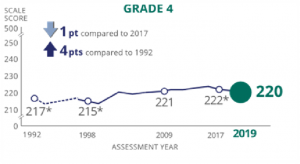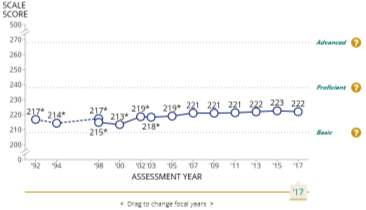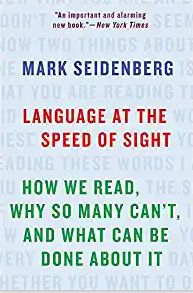It’s a new year–a new decade, in fact! It’s time for renewing optimism and realigning priorities. One of those priorities must be our education system because we are failing our children.
Reforming education is like turning a semi-trailer. It’s not easy, and it doesn’t happen fast. You need a lot of muscle and a lot of room to move. Nevertheless, it’s possible. You just need the know-how and the determination. We don’t appear to have either, and the consequences are staggering.
Failure #1: We Are Failing to Teach Reading
I know I’ve said it repeatedly, and I’m going to keep on repeating it: reading is the fundamental learning and communication skill. Without reading, our children never achieve their potential.
The reading scores for the 2019 NAEP (National Assessment for Educational Progress) test were released in November, and they show no improvement. In fact, the scores for fourth graders dipped slightly, and the scores for eighth graders dropped by five points.
In 2019, the national public average score for fourth graders was 219 out of 500. This was a one point drop from the previous test in 2017. More significantly, only 65% of the students met or exceeded the “basic” standard of reading skill, and only 34% met or exceeded the “proficient” standard.
We Are Failing to Improve
The NAEP test has been given nationally for decades, and scores are evaluated nationally and state by state. You can use the NAEP State Profiles Tool to check on your own state. You can even see results for the 27 largest school districts in the country. The results will not encourage you if you live in one of those districts.
The state profiles tool shows detailed results going back to 1992.  In that year, the national public score for fourth graders was 215, and 60% of those students met or exceeded the basic standard for reading skill. To be specific, in 27 years of assessing our effectiveness, our national public average score has only increased by four points!
In that year, the national public score for fourth graders was 215, and 60% of those students met or exceeded the basic standard for reading skill. To be specific, in 27 years of assessing our effectiveness, our national public average score has only increased by four points!
In addition, the percentage of students meeting or exceeding the basic standard has increase by just five percent. In fact, if you look at the graph, you’ll see that the average score in 2019 was one point lower than in 2017. How much more evidence do we need to conclude that we are failing our children in reading instruction?
Why Should We Care about Reading?
Why? To quote myself: reading is the fundamental learning and communication skill. Without reading, our children never achieve their potential. Okay, why should we care about fourth grade reading in particular?
Most school systems structure their reading instruction to be concentrated in the primary grades, first, second, and third. Because that’s true, fourth graders are assumed to be reading effectively, despite all evidence to the contrary. Thus, fourth grade curricula greatly increase the amount of reading for knowledge required.
Thus, imagine you’re one of the roughly one-third of fourth graders who doesn’t have basic level reading skill, and your reading assignments just doubled or even tripled. How are you doing to keep up? You’re not; you’re going to fall farther and farther behind each year. At some point, you will be likely to give up, act up, or drop out.
I’ll quote Matthew Ladner of the EducationNext blog quoting Shakespeare’s Henry V, “Here is a fellowship of death.” While we court failure in dramatic numbers, it doesn’t come close to the whole picture. We should remember that only 34% of the students tested could be considered proficient readers. Of course, that means that more than two-thirds are not.
We are failing our children, indeed, and we are paying for it everyday.





